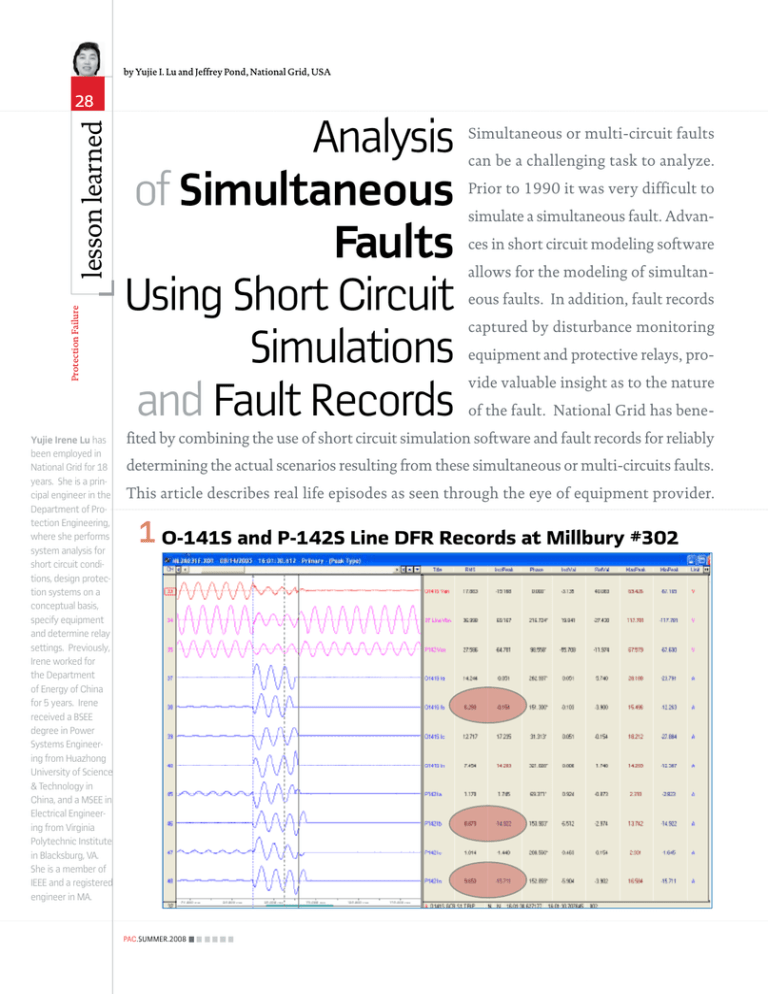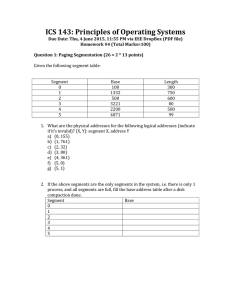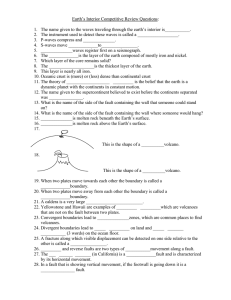Analysis Simultaneous of ned
advertisement

by Yujie I. Lu and Jeffrey Pond, National Grid, USA Protection Failure lesson learned 28 Yujie Irene Lu has been employed in National Grid for 18 years. She is a principal engineer in the Department of Protection Engineering, where she performs system analysis for short circuit conditions, design protection systems on a conceptual basis, specify equipment and determine relay settings. Previously, Irene worked for the Department of Energy of China for 5 years. Irene received a BSEE degree in Power Systems Engineering from Huazhong University of Science & Technology in China, and a MSEE in Electrical Engineering from Virginia Polytechnic Institute in Blacksburg, VA. She is a member of IEEE and a registered engineer in MA. Analysis of Simultaneous Faults Using Short Circuit Simulations and Fault Records Simultaneous or multi-circuit faults can be a challenging task to analyze. Prior to 1990 it was very difficult to simulate a simultaneous fault. Advances in short circuit modeling software allows for the modeling of simultaneous faults. In addition, fault records captured by disturbance monitoring equipment and protective relays, provide valuable insight as to the nature of the fault. National Grid has bene- fited by combining the use of short circuit simulation software and fault records for reliably determining the actual scenarios resulting from these simultaneous or multi-circuits faults. This article describes real life episodes as seen through the eye of equipment provider. 1 O-141S and P-142S Line DFR Records at Millbury #302 PAC.SUMMER.2008 by Yujie I. Lu and Jeffrey Pond, National Grid, USA 29 Case One: On August 14th, 2005, the National Grid System Control Center reported that at 16:01:30 a lightning stroke caused a fault on the 115kV O-141S line near the company’s Millbury #302 substation. The substation and faulted line configuration are shown in Figure 2. The circuit breakers O141 and 29-41 at Millbury #302 and O141S at Nashua St tripped correctly by the line protection relays. As per the report, at the time of the O141S operation, the 115kV P142S line, one of the parallel lines with the faulted O141S line, tripped by their line protection relays at Millbury #302 and Rolfe Avenue substations for the O141S fault. Targets reported for these two operations are shown in table1. Why did the P142S line relays respond to the O141S fault? Was it a single circuit fault only? First, the investigation team verified that both lines share double-circuit towers with a vertical design between table 1 National Grid has benefited from the use of digital fault records and short circuit simulation programs Millbury #302 and Rolfe Avenue, where the P142S line is more highly insulated than the O141S line. The conductor phasing arrangements, top to bottom, are B-C-A on the O141S and A-B-C on the P142S. Knowing the construction of these lines, it was believed that it would have had to have been a high current stroke to trip both lines. Next, the sequence-of-event and digital fault recorder (DFR) records captured at Millbury #302 were collected, which indicated that the fault occurred on both O141S and P142S lines at 3.06 miles from Millbury #302. Based on the records, the fault involved A-phase-, B-phase- and C-phase-to-ground on the O141S line and B-phaseto-ground on the P142S line with fault impedance (Figure 1). It was then further noticed that: The B-phase fault current flowed through the O141S and P142S from Millbury #302 were almost in phase, which implies that it was indeed a simultaneous fault. At the cursor (or trigger) point of Figure 1, Ib-O141S was 6.29 @ 151.30 and Ib-P142S was 8.88 @ 153.90 in secondary amperes. The B-phase and the ground (the zero-sequence current, 3I0) fault current flowed on P142S from Millbury #302 were in phase, which implies that the fault on the P142S was B-phase-to-ground. At the cursor (or trigger) point of Figure 1, Ib-P142S was 8.88 @ 153.90 and 3I0P-142S was 9.65 @ 152.90 in secondary amperes. Note: Current is shown in secondary amperes in the record. The CTR for the O141S and P142S relays at Millbury #302 is 3000:5. In order to verify that it was a double-circuit non-bolted fault and all line relays of O141S and P142S responded to the event correctly, a simultaneous fault was simulated by using the short circuit program Targets reported - case 1 Millbury #302: O-141S Directional Distance Zone 1, A- B- and C-Phase (DDZ1) O-141S Directional Ground Overcurrent (DG) Nashua Street: O-141S Directional Distance Zone 2, B-Phase and Ground (DDZ2) Millbury #302: P-142S Directional Distance Ground Zone 1 (DDGZ1) Rolfe Avenue: Targets were not reported. (Note: It is a municipal owned substation.) 2 One line diagram for O-141 & P-142 lines Note: At the fault location, O-141S and P-142S lines on a double circuit tower with a vertical design Millbury #302 Pratts Jct #225 29-41 0141 O141S 30-42 P142 Tripped by protected relay O141 P142S P142S Rolfe Ave O141 O141N Greendale Nashua St P142 P142 P142N 115kV #1 BUS 115kV #2 BUS W. Boylston Bloomigdale tap Wyman Gordon tap 115kV #2 BUS 115kV #1 BUS O141S Closed PAC.SUMMER.2008 Jeffrey Pond is a 27 year employee of National Grid. He is a Lead Technician in Protection Standards and Support Department, where he is responsible for the analysis of Transmission and Distribution system disturbances. and the selection, configuration and maintenance of disturbance recording equipment. Previously Jeff worked for the Substation Integration Team and the Relay and Telecommunications Operations Group. He received an Associate degree in Electrical Engineering Technology from Wentworth Institute of Technology, in Boston, MA, a BS in Business Management from Lesley University in Cambridge, MA, and a MS in Power Systems Management from Worcester Polytechnic Institute in Worcester, MA. He is a member of IEEE and is active in several working groups of the PSR Committee. Protection Failure lesson learned 30 Digital fault records provide valuable insight to the nature of the disturbance. simultaneous fault module. The simulation results proved that: The fault did involve A-, Band C-phase on the O141S lines and B-phase-to-ground on the P-142S line simultaneously, and It was a non-bolted fault with phase-to-phase and B-phase-toground resistance involved on the O141S and P142S line, respectively. Furthermore, to quantitatively match the fault records captured by the DFR at Millbury 302, more simulations were conducted with table 2 a different fault resistance on each phase. Finally, the results concluded that the fault resistance for the O141S three-phase-to-ground fault was approximately as follows: Ra = 5.0 primary-ohms, Rb = 11.3 primary-ohms and Rc = 7.0 primary-ohms, and the fault resistance for the P142S B-phase-to-ground fault, Rg, was around 6.5 primaryohms. (Figure 3 &Table 2) Case Two: On May 27, 2007 the System Control Center reported that at 23:33:32 a large oak tree fell on the S197 Line at Brittingham Hill Road near Tower 126 during a thunderstorm. At Bear Swamp 1019 the 197 and T31 circuit breakers (CBs) tripped, and at Deerfield 4 the 3T40 CB tripped (figure 4). At 23:33:33 the 1205W and 1205E CBs opened. At 23:33:37 the 197 CB closed auto and tripped immediately. All breakers were locked out. See table 3 for the reported targets for this disturbance. (Figure 4) The S197 Line fault was confirmed when the tree was found on the line. However, there was no evidence of a fault on the TR1 Line. The TR1 Line operation was a suspected improper operation of the directional ground (67N) protective relay. Was this an improper operation or a separate incident? Prior to the start of the investigation it was confirmed that the power system was operating normally prior to the fault and the generators at Bear Swamp 19, which is a pump storage facility, were off-line. The initial analysis using the one-line diagram in figure 4 agreed with the theory that the TR1 Line protection did mis-operate for the line fault because the faults were behind the protected zone of the TR1 directional ground relay. However, the Control Center report stated that the 1205W and 1205E tripped after the 197 and T31 CBs and before the 197 CB auto-closed suggesting this may be a separate event. The next phase of the analysis was to Simulation results of the simultaneous fault on: O-141S & P-142S Lines - (Output Report of Short Circuit Simulation Program) Simultaneous Fault: Bus Fault on: Bus Fault on: 50683 WYMAN 1 115. kV 3LG Ra=5 Rb=11.3 Rc=7 50686 WYMAN 2 115. kV 1LG Type=B Rg=6.5 SEE OUTPUT FOR THE FOLLOWING ACTIVE BUS(ES) 1: 50683 WYMAN 1 115 115.kV (O-141S) 2: 50686 WYMAN 2 115 115.kV (P-142S) BUS 50683 WYMAN 1 115 115.KV AREA 2 ZONE 1 TIER 0 (PREFAULT V=1.018@ -0.1 PU) + SEQ - SEQ 0 SEQ A PHASE B PHASE C PHASE VOLTAGE (KV, L-G) > 52.721@ -30.8 3.047@-136.5 3.306@ 115.8 49.148@ -32.1 50.411@-152.1 58.671@ 91.4 BRANCH CURRENT (A) TO > 0 MILLBURY2 115. 1L 6302.7@ 148.8 1565.3@ 103.3 1288.2@-165.1 8294.7@ 147.5 3537.7@ 27.4 7083.9@ -89.0 50680 ROLFE 1M115 115. 1L 1252.3@ 151.0 204.5@ 113.9 151.7@-171.5 1536.0@ 149.8 924.0@ 29.7 1298.6@ -86.7 CURRENT TO FAULT (A) > 7554.2@ -30.8 1766.7@ -75.5 1439.0@ 14.3 9829.6@ -32.1 4461.1@-152.1 8381.6@ 91.4 THEVENIN IMPEDANCE (OHM) > 3.97359@ 82.0 3.97106@ 81.9 8.67588@ 75.6 BUS 50686 WYMAN 2 115 115.KV AREA 2 ZONE 629 TIER 0 (PREFAULT V=1.018@ -0.1 PU) + SEQ - SEQ 0 SEQ A PHASE B PHASE C PHASE VOLTAGE (KV, L-G) > 54.857@ -19.6 6.196@ -27.4 11.203@ 106.0 55.105@ -10.9 48.806@-157.6 64.040@ 106.6 BRANCH CURRENT (A) TO > 0 MILLBURY2 115. 1L 1405.5@ 139.6 2022.6@ -96.1 1950.0@ 22.0 639.5@ -35.3 5375.8@ 22.1 546.4@ 98.4 0 ROLFE 115. 1L 1012.5@ 146.3 442.4@-103.6 553.2@ 23.9 566.2@ 141.1 2003.4@ 23.5 496.1@ -76.0 650 BLOOMDL 115 115. 1L 88.9@ 142.9 41.3@-104.8 0.0@ 0.0 82.6@ 170.4 129.9@ 20.5 71.5@-124.3 0 WYMAN GORDON 13.8 1T 0.0@ 0.0 0.0@ 0.0 0.0@ 0.0 0.0@ 0.0 0.0@ 0.0 0.0@ 0.0 CURRENT TO FAULT (A) > 2502.9@ -37.6 2502.9@ 82.4 2502.9@-157.6 0.0@ 0.0 7508.6@-157.6 THEVENIN IMPEDANCE (OHM) > 3.71194@ 82.3 3.70985@ 82.3 7.93466@ 75.2 Note: PAC.SUMMER.2008 Current is shown in primary amperes in the output report. 0.0@ 0.0 31 3 O-141S & P-142S line fault Note: At the fault location, O-141S and P-142S lines on a double circuit tower with a vertical design Millbury #302 29-41 0141 O141S O141S P142 If 3LG If Ra = 5.0 ohms Rb = 11.3 ohms Rc = 7.0 ohms Rfault 115kV #1 BUS 115kV #2 BUS P142S If 1LG (B-Grd) Rfault = Rg = 6.5 ohms Wyman Gordon tap 4 Greendale P142S P142 W. Boylston If Tripped by protected relay O142 Nashua St Rolfe Ave Bloomigdale tap 30-42 Closed S-197 One line diagram Note: All other CBs are closed Bear Swamp 19 TR2 Bear Swamp Switchyard 1019 TR4 13.8/230kV TR2-Line G2 Deerfield 4 230/115kV TR3 230kV BUS 2 197 GM2 2205W 115/69kV S-197 Line 3T40 2205E T31 67N TR1 1205W 13.8/230kV G2 E-131 Line 230kV BUS 1 Trip Line GM1 131 120SE Trip Closed Tripped by protective relay Open 5 S-197 Line One-Line Diagram – Initial Fault Note: All other CBs are closed Bear Swamp 19 TR2 Bear Swamp Switchyard 1019 TR4 13.8/230kV TR2-Line G2 TR3 230kV BUS 2 197 GM2 2205W 2205E T31 67N TR1 13.8/230kV G2 GM1 Deerfield 4 230/115kV 1205W Trip Line Tripped by protective relay 115/69kV S-197 Line Ph-Ph Fault caused by fallen tree 3T40 131 1205E E-131 Line 230kV BUS 1 Closed Trip Open PAC.SUMMER.2008 Protection Failure lesson learned 32 Several cases identify setting changes or control scheme improvements more efficiently correlate the reported targets and the fault records retrieved from the DFR at Bear Swamp Switchyard to determine the actual sequence of events for the fault. Analysis of the fault records determined the initial fault occurred at 23:33:29.610 when the tree fell on the S197 Line causing a B-Cphase fault. The 197 and T31 CBs at Bear Swamp and the 3T40 CB at Deerfield 4 tripped on DD Z1 S1 (figure 5). It was determined that the TR1 Line protection did not operate for the first S197 fault or immediately after. The fault record triggered at 23:33:34.802 shows the 197 CB auto closed, after five seconds, into a B-G fault, caused when a transmission tower was damaged as a result of the fallen tree, and tripped immediately (figure 6 & 8) on S197 IOC B-ph. At the same time the TR1 Line DG relay operated initiating transfer trip to the Bear Swamp Powerhouse, and tripped the 1205E and 1205W CBs (figure 7 & 8). The S197 and TR1 Line table 3 6 197 CB Auto-Close into B Ph – Gnd Fault at 23:33:34.802 7TR1 & TR2 Line Waveforms Second Fault at 23:33:34.802 Targets reported - case 2 Bear Swamp Switchyard 1019: S-197 Directional Distance Fault Detector System 2 (DDFD S2) S-197 Instantaneous Overcurrent System 2 (IOC S2) B-Phase S-197 Directional Distance Fault Detector System 1 (DDFD S1) S-197 Directional Distance Zone 1 System 1 (DD Z1 S1) TR1 Line Directional Ground System 1 (DG S1) Bear Swamp 19: TR1 System 1 Transfer Trip Deerfield 4: S-197 Directional Distance Zone 1 (DD Z1 S1) 8 S-197 Line One-Line Diagram – Simultaneous Fault Note: All other CBs are closed and accurately, Bear Swamp 19 TR2 Bear Swamp Switchyard 1019 TR4 13.8/230kV that make the transmission CBs were at lockout after the second fault occurred. At this point it was clear the TR1 Line operation was not a separate incident but was the result of the auto-close attempt to re-energize the line. The investigation now focused on what caused the TR1 Line directional ground relay to operate. Further analysis of the fault record in figure 7 determined that the TR1 Line supplied zero-sequence fault current at the time the 197 CB auto-closed. The record shows that the TR1 Line A-, B-, and C-phase currents are additive and are summed in the TR1 Line neutral-current. The results obtained from the analysis now indicate that the TR1 Line directional ground relay operated properly for this fault condition. To confirm the TR1 directional ground relay operated properly for the fault, a short circuit simulation was performed. If the relay operated for the conditions in the fault simulation it would prove the operation was correct, while verifying that National Grid’s system model TR2-Line G2 TR3 230kV BUS 2 197 GM2 2205W system more 2205E T31 67N reliable TR1 13.8/230kV G2 GM1 1205W Trip Line Tripped by protective relay PAC.SUMMER.2008 Deerfield 4 230/115kV 131 1205E 115/69kV S-197 Line B Ph-Gnd Fault caused by damaged tower 3 Ph-Gnd Fault caused by fallen tree E-131 Line 230kV BUS 1 Closed Trip Open 3T40 33 Fault records and short circuit programs have provided the engineer with tools that allow them to verify protection system operation. was accurate. The simultaneous fault module would not allow placing two faults on the same line segment, therefore, it was decided that in order to create the simultaneous fault in the short circuit model first, a phase to ground fault was placed on the 115kV Bus at Bear Swamp because tower 126 where the B-phase to ground fault occurred was approximately one mile from the Bear Swamp Switchyard. Second, a three phase to ground fault was placed on the S197 Line near Bear Swamp (figure 9). The simulation confirmed that the Directional Ground relay, which is a Westinghouse IRQ-9 with negative sequence polarizing, had sufficient polarizing volt-amperes in the forward direction and neutral current to operate. As a final check the TR1 line negative sequence quantities were calculated from the fault records to be 2.88VA, well above the 0.76 VA minimum pickup of the relays directional unit, and the phasors were compared to the IRQ directional unit characteristic. As can be seen in figure 10 the calculated negative-sequence components are similar and match the relay characteristic. Based on the analysis it was determined that for the initial fault the S197 Line directional distance protection operated properly at both Bear Swamp Switchyard and Deerfield 4 for the B- to C-phase fault caused by the falling tree. After the initial phase to phase fault the tree came to rest across all three phases of the S197 line creating a permanent three-phase to ground fault and causing damage to Tower 126 which is lattice steel construction. As a result of the damage caused by tree falling on the line a permanent B-phase to ground fault was created on the S197 Line at tower 126. When the 197 CB closed auto in five seconds the B-phase to ground fault, caused by the damaged tower, was supplied by the S197 line at Bear Swamp. The TR1 Line supplied zero-sequence current to the three-phase to ground 9 fault through the Generator 1 GSU at Bear Swamp 19 as was determined from the fault record (figure 7). Based on the analysis the TR1 Line DG relay operation was determined to be a correct operation even though the two faults were behind the relay. Short Simulation Fault Locations The short 39@89 Bear SWMP 23 230kV 598 2.7@179 38@104 circuit program 424@90 0.0@0 420@90 0.0@0 Bear Sw G2 13.8kV 0.0@0 Bear SwG1 13.8kV 0.0@0 920@89 Bear Sw4T 0.01kV 0.0@25 1674099@54 21149047@91 HARIMN X TP 115kV 922 4.2@180 19803382@91 T 831@104 0.0@93 T Monroe 13.8kV6935 Bear Sw 13.5 0.0@0 13.8kV 911135 0.0@0 T HoosacLow Bear Sw 13.6 0.0@0 0.575kV 13.8kV 911136 0.0@0 such as the simultaneous Bear Sw 115 115kV911 5.7@177 1722@89 831@76 features 0.0@115 4483@103 4484@103 DEERFIEL4 23kV 0.0@155 fault module have aided 3 Ph to Gnd 0.0@65 Fault 278@41 278@139 278@41 T DEERFIEL4E3T 0.10@50 0.01kV80968 278@139 0.0@155 1394@48 6994@81 DEERFIEL4 1118@130 1394@132 T B Ph to Gnd 115kV 0.0@156 DEERFIEL4A3T Fault 0.01kV80965 0.0@165 60 120 or multi-circuit IAZ faults 43 150 I2 = 0.4 A 30 H2 180 0 42 V2 = 7.23 V 210 Contact Closing Torque o 0 Zero Torque VAZ 330 240 the analysis of simultaneous Polarizing Comparison with IRQ Characteristic Max Torque engineer in faults including 10 TR1 Negative Sequence 90 the protection 0.0@93 0.10@130 300 270 PAC.SUMMER.2008






